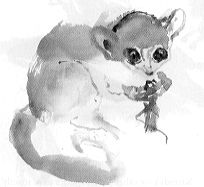
Chez Maggie
Hotel & Restaurant
Morondava
Chez Maggie / TRIPADVISOR: 2012, 2013 & 2014 Certificates of Excellence
| Sustainable Tourism |
| Responsible Travel Links |
| Safety, Health & Communication |
| International Travel Issues & Embassy Links |
| Country Information & Tour Information |
| Booking Procedure Travel Documents |
| Getting There |
| Request Information |
Gallery: Natural History |
|
|
The gray mouse lemur (Microcebus muriosus)
can also hibernate for months, but in this species
only adult females do it. Like their fat-tailed
cousins, female gray mouse lemurs go through their
reproductive cycle between late December and early
February, aquiring impressive amounts of fat and
increasing body mass by more than 40 percent. As
the nights begin to get cool, these two-ounce
lemurs resort to another remarkable strategy to
reduce energy expenditure: night-time torpor. When
the temperature falls below a certain point, they
enter a tree hole and reduce metabolism, thus
lowering body temperature close to the level of air
around them. (Some of our colleagues have reported
body temperature as low as 48°F in torpid
animals.)
 Huddling together in well
insulated holes further enhances their energy
savings. When the ambient temperature rises during
the morning, body temperature follows passively up
to about 82°F, at which point the metabolism
kicks in again and heats the lemurs up to a normal
level of about 100°F. As the dry season
progresses, adult females stop leaving the tree
hole altogether, remaining inactive for the next
four months or more. Males, however, continue
venturing out to forage (mainly on gum and the few
remaining insects) for at least a few hours almost
very night. Why they forgo the substantial energy
savings enjoyed by females and expose themselves to
owls and other predators every night is something
of a mystery to us. However, the mating season
begins soon after the female emerge, and we think
the males may be taking advantage of these months
to establish dominance hierarchies. Huddling together in well
insulated holes further enhances their energy
savings. When the ambient temperature rises during
the morning, body temperature follows passively up
to about 82°F, at which point the metabolism
kicks in again and heats the lemurs up to a normal
level of about 100°F. As the dry season
progresses, adult females stop leaving the tree
hole altogether, remaining inactive for the next
four months or more. Males, however, continue
venturing out to forage (mainly on gum and the few
remaining insects) for at least a few hours almost
very night. Why they forgo the substantial energy
savings enjoyed by females and expose themselves to
owls and other predators every night is something
of a mystery to us. However, the mating season
begins soon after the female emerge, and we think
the males may be taking advantage of these months
to establish dominance hierarchies.
|
|
<<< previous page |
next page >>> |
Remote River Expeditions in Madagascar, Ethiopia, Tanzania - River Trips and Tours
Experience the romance of East Africa. We invite you to join one of Remote River Expeditions' adventures into Madagascar, Ethiopia, and Tanzania and see the atrractions of those countries. Each trip is completely unique. Each expedition has its own special challenges and serendipitous, human connections. What you can expect in every instance, however -- and why many of our clients return, year after year - is an outstanding wilderness experience including great food, magnificent wildlife, and friendships forged that last a lifetime.remote, rivers, rivertrips, river, trip, tour, rafting, east, africa, madagascar, ethiopia, tanzania, rafting, tour, camping, trip, expedition, challenge, wilderness, animals, birds, lemmer, gary, gallery, expeditions, birding, gameviewing, watercolor, paint, painting, whitewater, paddling, vacation, beach, Selous, Omo River, Rufiji River, Zambezi, Tsiribihina, Mangoky river, scenic, natural, cultural, conservation, floral, fauna, lemurs, safaris, Zambezi, birdwatching, adventure, exploration, Afrika, nature, Africa
All Rights Reserved
© 2001-2024 RRE
© 2001-2024 RRE



